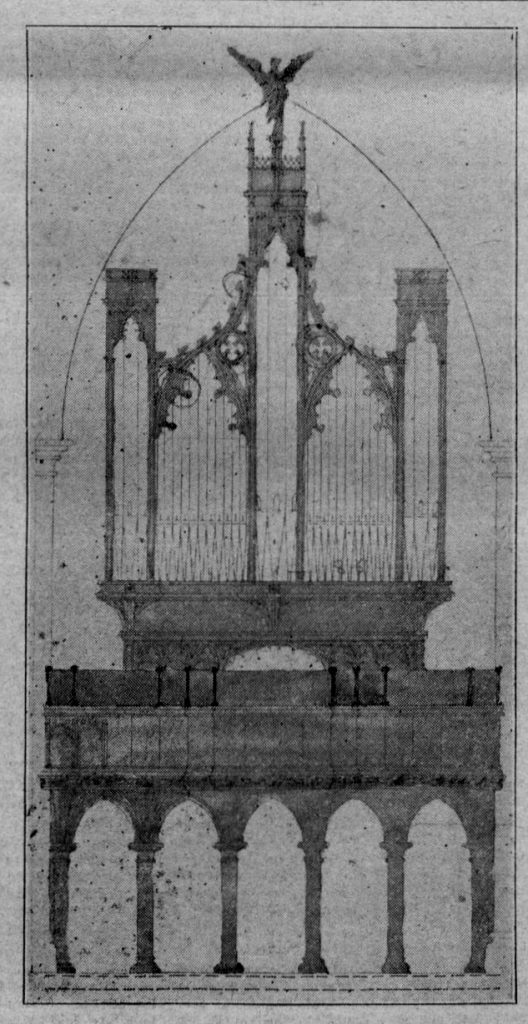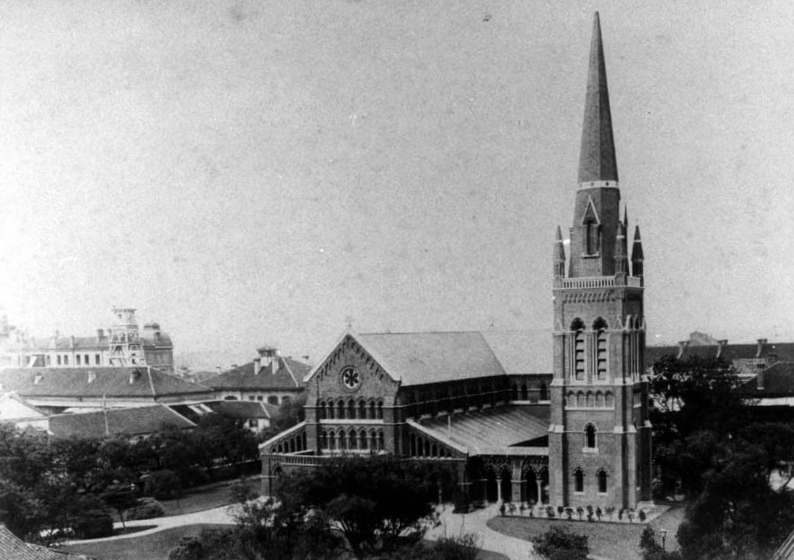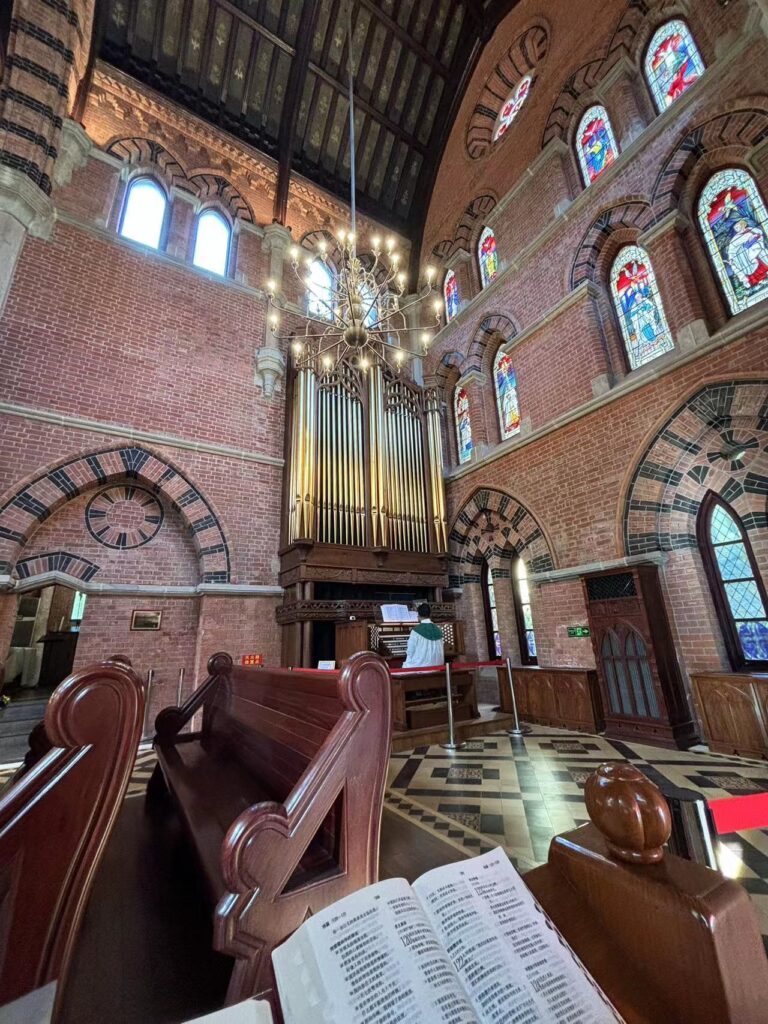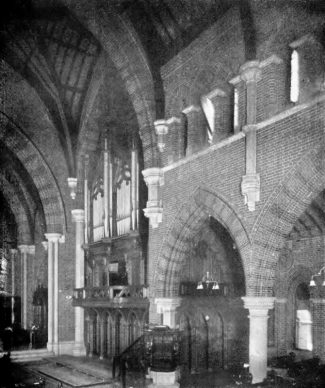SHA1925
| Census ID | SHA1925 |
|---|---|
| Location | Shanghai, Holy Trinity Cathedral |
| Builder | Harrison and Harrison |
| Specs | III/45+Ped |
| Action | Tubular pneumatic ‘exhaust’ system |
| Cost | 8,012.5 GBP |
By the start of the First World War the authorities at Shanghai’s Holy Trinity Cathedral admitted that the Walker organ of 1883 (SHA1883a) needed to be replaced, a relic of the infrastructure of a pre-electric age. A report on the “Proposed Renovations” noted, among many other failings, that “the organ is hand-blown by Chinese coolies.” Initially the plan was to retain most of the Walker pipework and commission a massive rebuilding of the organ, but it became apparent that the cost of this would not differ significantly from that of a new organ, and bids for a new installation were solicited in 1919. The specs of SHA1925 were drawn up by the titular organist, Ronald B. Hurry, and a contract with Harrison and Harrison was signed in July 1920.
| Great (C to c3) |
Double Open Diapason 16′ Large Open Diapason 8′ Small Open Diapason 8′ Hohl Flute 8′ Stopped Diapason 8′ Octave 4′ Wald Flute 4′ Octave Quint 2 ⅔′ Super Octave 2′ Harmonics 17/19/21/2 Tromba (harmonic trebles) 8′ Octave tromba (harmonic trebles) 4′ |
| Swell |
Lieblich Bourdon 16′ Open Diapason 8′ Lieblich Gedeckt 8′ Echo Gamba 8′ Voix Célestes (from Ten. c) Gemshorn 4′ Lieblich Flute 4′ Fifteenth 2′ Mixture 12/19/22 Oboe 8′ Vox Humana 8′ Double Trumpet 16′ Trumpet 8′ Clarion 4′ |
| Choir |
Contra Viola 16′ Viole d’Orchestre 8′ Viole Céleste (to f2) 8′ Violin Diapason 8′ Harmonic Flute 8′ Salicet 4′ Concert Flute 4′ Harmonic Piccolo 2′ Orchestral Bassoon 16′ Clarinet 8′ |
| Pedal C to g1 |
Double Open Wood 32′ Open Wood 16′ Sub Bass 16′ Open Diapason 16′ Violone 16′ Octave Wood 8′ Flute 8′ Ophicleide 16′ Posaune 8′ |
| Couplers | GT/Ped (pistons combined), SW/GT, SW Octave, SW/CH, CH Octave, CH Suboctave, CH/GT, CH/Ped, SW/Ped, |
| Accessories |
CH Unison off (used in conjunction with extra stop, ‘Orchestral Hautbois’ 8′, from Orchestral Bassoon). Reversible pistons: GT/Ped, SW/GT, SW tremulant, CH tremulant; Reversible pedal, GT/Ped, Ped/SW pistons, Ped Ophicleide reversible. Crescendo pedal for SW, Tremulants SW; Tremulants CH, Crescendo pedal for CH; Reeds on CH, Combination pedals: GT, 6; SW 6; CH 5; Ped, 6. |
The organ was expected in 1923, but it did not arrive until 1925. This was due in part to what The North-China Herald called “labor troubles in England”, and further due to the increasingly chaotic political situation in Republican-era China. Delays were also experienced by the ‘discovery’ that a platform (tribune) would be needed to lift the whole organ ten feet off the ground (see main photo and drawing below.) Fortunately, a donor was found for this and a gift of 25,000 taels from architect and property developer Henry Lester (1840-1926) allowed the work to go forward.
Harrison and Harrison finished the “War Memorial Organ” in November 1924, and sent it out to Shanghai via Suez and Hong Kong along with two organ builders, Austin Jones, and his brother, Doyley. The organ arrived on 4/5 May 1925, and was brought from the docks in Hongkou to the Cathedral, “nearly two miles, on hand carts by coolies” as Austin Jones reported back to Durham.
The finished instrument contained 2,630 pipes and had tubular pneumatic ‘exhaust’ action throughout, except for mechanical couplers, and was tuned to what the builder called “the new French pitch, i.e. C = 517 vibrations per second at 60 degrees.” The Jones’ finished their work at the end of September, and the organ was inaugurated on 14 October 1925. The organist for the service was W.J. Dexter (R.C. Young, Hurry’s replacement, was on home leave.) The whole project had taken almost seven years.
What happened to the organ after 1949 is not clear. According to anecdotal reports collected by the Project in Shanghai, SHA1925 was still in the church 20 years later when the police took over the building around 1969 in the middle of the Cultural Revolution, but that it was later discarded. The cathedral was restructured internally in 1977 as a three-story building, the ground floor of which was used as a theater.
Holy Trinity Cathedral in Shanghai had to wait until 2004 to be returned to a TSPM (Three Self Patriotic Movement) congregation representing the Chinese Anglican Church. In the run-up to the 2010 Expo, Harrison and Harrison received an inquiry from the TSPM in Shanghai with a request for a quotation to ‘exactly’ replicate SHA1925. Costs prevented this, and in the end the Hong Kong Sheng Kung Hui donated a Rodgers electronic “Classic Organ” (Model T1038) to the church in May 2010 (photo). As part of the renovations, in 2010 St. John’s Cathedral in Hong Kong (to which many members of the Shanghai congregation had drifted after 1949) donated 900,000 HKD for new stained glass windows.
A partial account of the renovation of the cathedral can be found here: http://articles.latimes.com/2011/feb/27/entertainment/la-ca-shanghai-cathedral-20110227

Original design for the organ, elevation. As this shows the tribune required for installation, it is unclear why this was built only at the last minute.

Holy Trinity Cathedral, Shanghai, after the turn of the 20th C., when the bell tower was erected.

Facade of SHA1925

The Rodgers electronic organ now in use at Holy Trinity Cathedral, occupying part of the original organ chamber (photo kindly provided by Prof. Wang Xiaohu).
